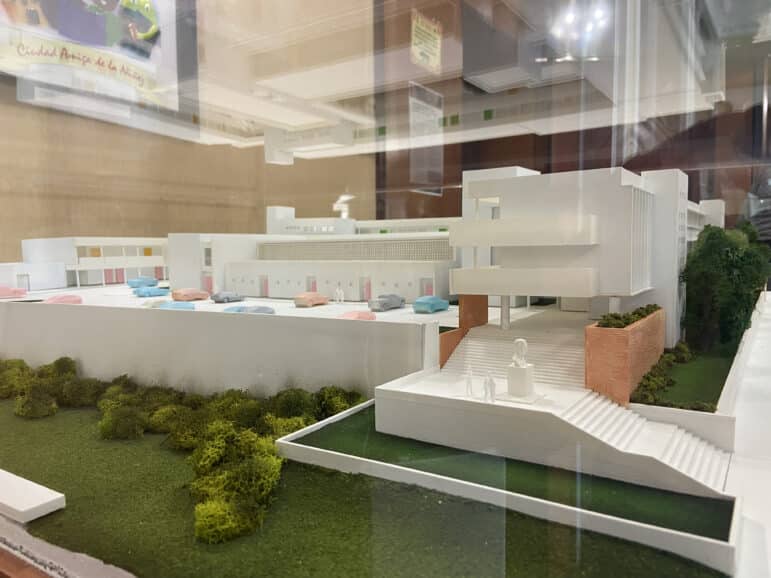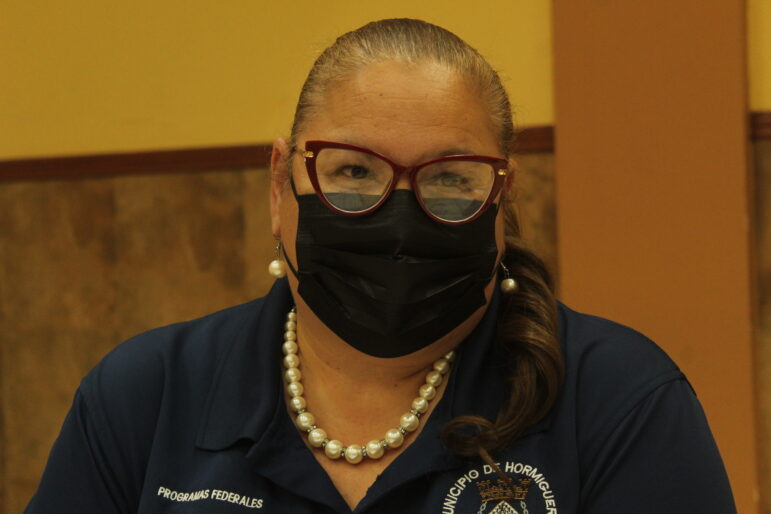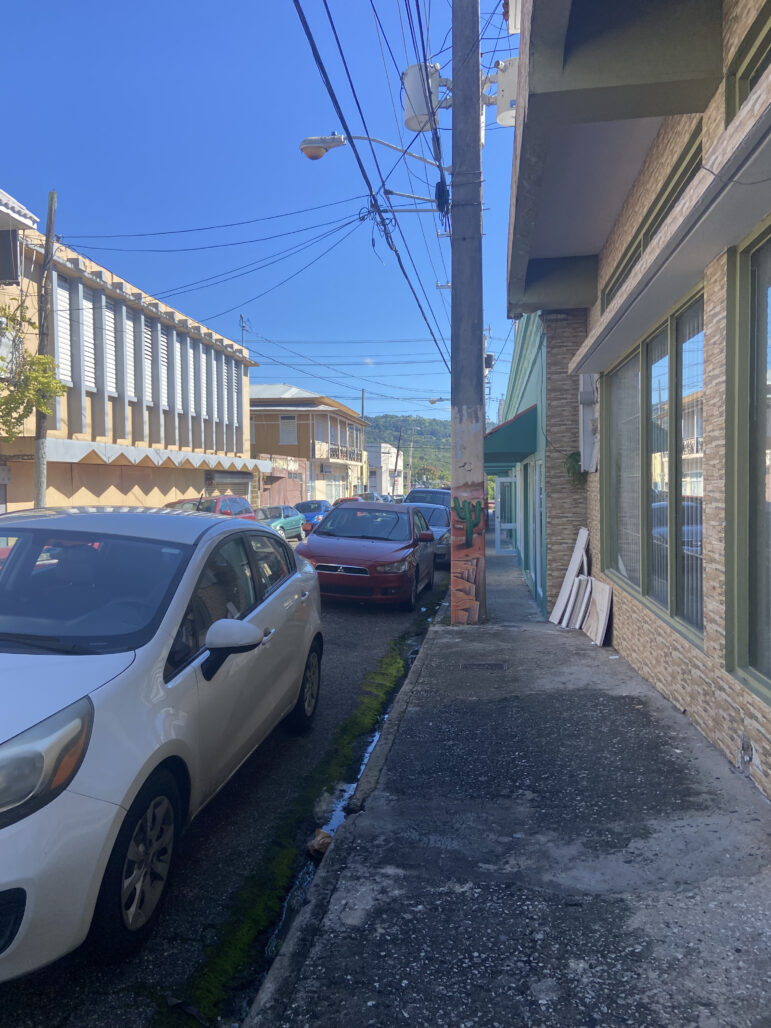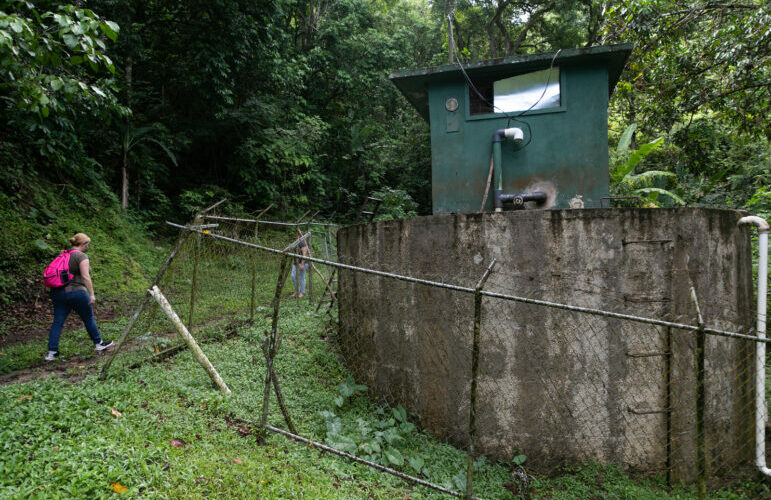Photo by Alanis M. Torres Soto | Centro de Periodismo Investigativo
Aibonito public square
Almost two years ago, the Municipality of Orocovis proposed building a viewpoint on PR-155, one of the town’s main roads. To the surprise of the city’s Deputy Administrator, Samuel A. Rodríguez González, the Department of Housing’s (DV, in Spanish) City Revitalization Program (CRP) rejected the proposal because it would not be built in the town’s urban center, something that consulting firm Horne did not warn about.
In Loíza, the roads and parks improvement projects under this program have been delayed because they have had to redo the proposals due to contradictory indications from the firm Plexos, said Yeidy Escobar Del Valle, director of the town’s Planning, Territorial Organization and Economic Development Office.
While in Mayagüez, the manager of Municipal Housing and Federal Programs, Javier Román Ruiz, assured that the town had to withdraw an already approved preschool education project, because it was not notified in time by contractor Tetra Tech about when it had to submit the environmental review documents that the CRP required.
Poor advice from the contracted companies, combined with changes to online work platforms and government amendments to the program guidelines, are the main reasons for the delay in CRP projects, according to officials from 10 municipalities that the Center for Investigative Journalism (CPI, in Spanish) interviewed.
Since 2018, Horne has been paid $251 million in Housing contracts. Since 2019, its main function is to manage and supervise the million-dollar grants, as grant manager, of federal funds for disaster recovery after Hurricane María, known as CDBG-DR, assigned to Puerto Rico.
Meanwhile, the DV contracted firms ICF Incorporated, Tetra Tech and Plexos Group in August 2021 to oversee the City Revitalization Program and other infrastructure programs. Its contracts total $66 million to help municipalities develop reports and analyses, supervise their construction projects, and submit progress reports on the program’s management platforms, according to Housing. These companies were chosen through a competitive process.
Rehabilitating urban centers was at the top of the list of priority projects in Gov. Pedro Pierluisi’s platform, as the Reconstruction Council established in 2021.
If the projects have not been completed by 2025, the federal funds allocated will have to be returned, said Housing Secretary William Rodríguez Rodríguez in an interview with the CPI on November 29, 2022. The next day, Housing asked the US Department of Housing and Urban Development (HUD) for an extension of CDBG-DR funds through 2028.
This program, launched three years ago and which seeks to revitalize urban centers and its key corridors after Hurricane María in 2017, has almost $1.3 billion in CDBG-DR funds available.
“We have to impose an execution calendar on ourselves and our subrecipients so that at the end of the day we can carry out projects that comply with the program and that we do it within the established timeframe because we know that 100% of the funds allocation must be returned if 100% of the work is not completed,” Rodríguez Rodríguez warned.
“We cannot be executing thinking that they’re going to give us extensions that we don’t know about,” he added about the prerogative of HUD, which has not yet answered Housing’s request to extend the time to use these funds.
“What we want is for [the municipalities] to get going on the bidding processes,” he said. “That they move to do the projects,” said the Housing Secretary.
Housing launched an unstructured program
Gov. Pedro Pierluisi said that the repairs to the Aibonito public square would be completed by September 30, 2022, after the significant damage to lighting and fixtures that Hurricane María caused. Pierluisi announced it in November 2021 when he formalized the City Revitalization Program’s first reconstruction project.
To this day, the Segundo Ruiz Belvis town square in Aibonito is still under construction. In this town, the public square is the only of the four projects approved worth $9.6 million that is under construction.
Although there have been problems like a lot of rain and changes in the design of the plaza, the director of Aibonito’s Federal Programs Office, Angélica M. Camacho González, believes that the delay in the town’s projects is due, in part, to the Department of Housing’s lack organization. After signing the agreement with Housing, two years and five months ago, the official realized that this agency initially did not have an educational, evaluation, and financial structure for the CRP, she told the CPI.
It was not until a year after signing the agreement that the agency assigned ICF Incorporated to manage the program in Aibonito.
Orocovis submitted the viewpoint project on June 21, 2021 with contractor Horne’s advice, Rodríguez González said. However, this company, which was supposed to know the scope of the project, did not warn the municipality that the project could be rejected.
The Housing Secretary said, in addition to not being in the urban area, the project was denied because it did not meet the requirement of being associated with the needs created after hurricanes Irma and María.
Orocovis Mayor Jesús Colón Berlingeri reiterated to the CPI that the viewpoint was rejected because it was not in an urban area. At press time, neither Housing nor the municipality of Orocovis provided the CPI with the letter that specified the reasons for the project’s rejection.
Municipal official Rodríguez González said that Housing never told him how to determine that a project is in an urban center or on a community corridor.
“We proposed a project [the viewpoint] that is practically [at] the entrance to Orocovis,” explained Rodríguez González. “For us that is the entrance to the town; the entrance to welcome those who come to ‘chinchorrear,’ to do tourism.”
The municipalities of Loíza, Aibonito and Toa Baja are not clear about these delimitations either, municipal officials Escobar Del Valle, Camacho González and Alexis Ramos confirmed separately to the CPI.
The four program guides do not define what an urban area or a corridor (road connector) is, nor does it specify which maps should be used to define these concepts. Two of the guidelines only say that “all projects must be located within municipal limits and within a designated downtown area or a key growth corridor that is defined by the municipal government or identified by other eligible entities.”
When the CPI asked, the Housing Secretary said his agency uses the Puerto Rico Planning Board’s definition of urban area. As for what a corridor is, he added “we’re very open in the interpretation, so that we can benefit the municipalities.” However, he admitted that none of the definitions are listed in the guidelines.
Urban corridors are “urbanized areas within or adjacent to the urban area where there are homes, shops, public or private facilities that provide some type of service to the residents of the municipality. It can also include areas with an urban type of designation by the Planning Board,” said Rafael J. Vega González, Housing’s press officer. This definition, however, is not included in the guidelines.
The president of the Puerto Rican Planning Society, Tomás J. Torres Placa, explained that the definitions of urban center, urban and community corridors vary according to each municipality’s Land Management Plan (POT, in Spanish). The Planning Board told the CPI that 63 municipalities have their POTs approved.
The municipality of Salinas submitted a project for a passive park for CRP’s consideration. Even though the project would not be developed in the urban center, but rather on PR-1, Horne recommended that the town submit it because it would still comply with the program guidelines by being built in an urban corridor, according to the director of Federal Programs for Salinas, Yarida Oppenheimer. However, the project was rejected because it is in a rural area and did not meet the requirement of being associated with the needs created after the hurricane, according to a document issued by Housing.
“As one of the urban center’s main corridors, we intended to fight coastal zone erosion with reforestation. As a passive park, it was intended to attract visitors and tourists to contribute to the revitalization of the urban center,” Oppenheimer explained.
Although the Housing Secretary said the main reason for rejecting it was that it was in a flood prone zone, the program’s main guidelines indicate that, even if they are in a flood prone zone, projects can be developed if they meet the Federal Emergency Management Agency’s (FEMA) elevation and protection requirements against floods.
The Housing Secretary said it is up to the municipalities to submit their projects for consideration to the agency because it is up to the program managers to guide them. However, he acknowledged to the CPI that there have been changes in the personnel handling cases due to their poor performance. He acknowledged that there have been problems in the communication flow, in addition to discrepancies in the interpretations of the project requirements or eligibility.
“Any breach can lead to a cancellation of a contract. And [removal of] any of the three contractors has not been ruled out,” he added, referring to ICF Incorporated, Tetra Tech and Plexos Group.
Glorimary Arregui, Horne’s supervisor of External Relations and Communications in Puerto Rico, said the company would not comment on complaints from municipalities about its management work.
Plexos Group’s marketing director – who is also identified as media contact – Christine Armstrong, said she could not comment.
Meanwhile, Charlie MacPherson, in charge of media and public relations for Tetra Tech, did not return calls, text messages or emails.
Decisions that delay projects
Planner Escobar Del Valle explained that when preparing the Loíza proposals, Plexos Group assured the municipality that Housing did not require that project descriptions go into technical details, such as cost estimates and project schematics. However, that turned out to be false. For Escobar Del Valle, this situation reflects poor communication between the agency and the company. The process has been delayed because she said including that information takes more than a month.
Escobar Del Valle said given the experience that the municipality of Loíza has in managing federal funds and proposals, it has had to guide Plexos on how to proceed with different matters related to the CRP, even though the firm is paid to assist Loíza in the project approval process.
“I understand that these programs require these intermediary resources between Housing and the municipality,” said Escobar Del Valle. “However, the evaluation and interpretation criteria of these intermediaries change depending on the evaluator,” she said, referring to Plexos and Housing, which has delayed the construction of projects approved for Loíza.
To break ground on a project under the CRP, the municipalities as well as Horne, Housing, and the program managers — ICF Incorporated, Tetra Tech and Plexos Group — must complete 12 steps.
“The approved projects haven’t been built because it is necessary to carry out an entire process before reaching that stage,” Brenda Mangual Vázquez, special aid to Toa Baja Mayor Bernardo Márquez said.
When the municipality of Mayagüez submitted a preschool education project, which would combine funds from the Head Start and City Revitalization programs, it thought that the process would be expedited because the structure had already been designed. They also submitted the environmental reviews required by Head Start and the government of Puerto Rico to the CRP.
Furthermore, the manager of Municipal Housing and Federal Programs of Mayagüez, Javier Román Ruiz, told the CPI that Tetra Tech, the company that Housing assigned to the municipality, told them that the projects that used CRP funds as matching were the ones they preferred because they could be moved forward quicker than new projects.
Tetra Tech even went so far as to tell him that with this project it could be one of the first municipalities to get funds, Román Ruiz said. However, the company did not guide them in time about the order of the processes. Three to four months passed when Tetra Tech asked the municipality if any demolition had been done at the site. At that time the demolition had already begun.
Tetra Tech then informed the municipality that it should not have demolished if it had not first completed the environmental documents. Along with the demolition, the municipality had begun working on the environmental review documents required by CRP but had not completed that step. Mayagüez opted to withdraw the project because they could lose the funds allocated by Head Start.
“We lost three months of that project,” said Román Ruiz. “They [Tetra Tech] had all the documents at hand from day one.”
The municipal administrator of Aguada, Marisol Rosa Acevedo, claimed that the approval of the environmental review forms has been slow. Meanwhile, Sandra E. Rosas Vélez, director of Hormigueros Federal Programs, noted how complicated it has been to complete documents required by HUD.

Flip-flop in guides and platforms
Another reason for the delays with the CRP was the change of online work platforms, said the Hormigueros municipal official. Rosas Vélez said from February to August 2021, the municipality used the Subrecipient Agreement Performance Report Portal platform to submit monthly program progress reports. However, in September of the same year, Housing and Horne migrated to another platform: the Grant Compliance Portal. Her team had to learn to use the new platform on the go, which meant a delay.

Housing said through the Grant Compliance Portal municipalities submit their monthly progress reports, send their bid notices, and submit requests for information to the programmatic area.
When asked by the CPI if changing platforms was a Horne or Housing decision, the Secretary said that the agency makes those types of determinations.
“The grant manager [Horne] can recommend, just like the program managers, but the determinations are up to us [the Housing Department],” he said. “We’re the ones doing the acquisitions. We’re the ones who run the competitive processes,” he said referring to the purchase of the program platforms.
Program guidelines have also changed, delaying the construction of projects in Yauco, Loíza, Mayagüez and Hormigueros, interviewed municipal officials said.
According to the Housing Secretary, these guidelines are amended when the agency decides to do so. The CRP’s general guidelines is already in its third version. “In each of the [new] guides, new requirements were usually established for project approval,” said the director of Federal Funds and Infrastructure for the municipality of Yauco, Martínez Pueyo.
In addition to the general guideline, the CRP has other guidelines for economic development, cross-cutting and affordable housing projects.
Municipalities with the most funds approved under the City Revitalization Program
The Aguadilla press officer, Jossie I. Vega Santiago, said the municipality had not found — at the time of this interview — a designer for three of its approved projects given a shortage of engineers interested in competing in the bid processes or Request for Proposals (RFP).
“The longest process has been that of procurement [hiring] because of the low participation rate of engineers and architects,” said Vega Santiago. After this phase, the process moves on to project design and permit management to begin construction.
Gurabo Mayor Rosachely Rivera also said, given the low attendance by proponents at municipal bids due to lack of employees and inflation, she is not entirely sure when construction of her revitalization projects will be completed.
The Mayor of San Sebastián, Javier Jiménez Pérez, did not want to comment on the extension of the program’s closing date. He only said his projects must be finished on time to avoid having to return the federal program funds.

To hire the companies to design their projects, Jiménez Pérez said it was necessary to hold two rounds of bids because the proponents’ rates in the first round were “ridiculously high.”
Against the clock?
Governor Pierluisi said in January, during a press conference in Orocovis, that construction projects under programs like City Revitalization take “a great deal of time.”
He put part of the responsibility for the delay in the construction of projects like those under the CRP on the restrictions imposed by former US President Donald J. Trump’s administration.
“We had some obstacles in these programs before my administration and that of President [Joe] Biden’s began, both in CDBG and in FEMA,” the Governor said.
It took two years from 2018, when HUD announced the CDBG-DR grant to Puerto Rico, before the Department of Housing could use federal funds. The federal government shutdown for a month and the lag of then HUD Secretary Ben Carson in approving the local Housing Action Plan and signing the final agreement were some of the issues that delayed access to these funds.
Although the Housing Secretary emphasized to the CPI that his agency has imposed a 2025 deadline on municipalities to complete the program’s projects, given that the main grant’s closing date is in 2026, he is waiting for HUD to answer his request this month to extend the use of these funds until 2028.
Hurricane Fiona in September 2022 offers “a good case” for HUD to extend the period, he said.
Luis Joel Méndez González and Vanessa Colón Almenas are members of Report for America.

8 septiembre, 2022 LEER MAS